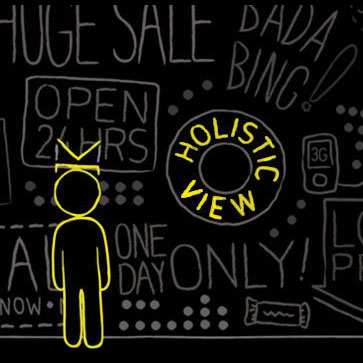PPC Accountability

by Peter Devereaux
31 Jan, 2008
Is Tracking ROI Actually Hurting Your Business?
By Rafe VanDenBerg
__________________________________________
For ecommerce companies and Internet retailers, measuring and managing return-on-investment (ROI) seems to be the Holy Grail of pay-per-click (PPC) accountability. Everyone seems to be working toward the day when they can measure and adjust their PPC campaigns by the actual profit-contribution-per-dollar-spent. After all, it just makes good business sense, right?
Not necessarily. While this may sound like blasphemy to some, for many ecommerce companies and Internet retailers, measuring and managing PPC campaigns by ROI could actually be hurting their growth and profits.
PPC and New Customers
Analyze the PPC campaigns of a typical Internet retailer and you'll often find these campaigns are primarily producing new customers and very little repeat customer activity.
Intuitively, this makes perfect sense. Many new customers will initially find the retailer by conducting a search then clicking on a PPC listing. Less likely, however, is that these customers will follow this same search-to-PPC path when making subsequent visits or purchases. These customers are already familiar with the retailer and know what they have to offer. And, as existing customers they are probably receiving regular follow-up communications from the retailer. So, for subsequent purchases there's little need for these customers to use a PPC listing.
This new customer distinction is important because it can radically change the profitability picture associated with PPC - particularly for a multi-line, multi-channel Internet retailer. When PPC campaigns are generating a large percentage of new customers, it becomes much more appropriate to view PPC as a customer acquisition mechanism, rather than a transactional tool. And when the perspective changes to customer acquisition, the concept of customer lifetime value (LTV) must come into the picture. Put simply, LTV is the net-profit generated over the period of time a customer remains active.
Any multi-line Internet retailer should know that a new customer is often worth far more than the revenue and profits associated with their initial transactions. For some online sellers, the initial transactions are just the tip of the iceberg as those customers return again and again, over a longer period of time.
LTV and PPC Profitability
When LTV is considered, it's easy to see how a new customer acquired through PPC could be worth much more than just the near-term revenue associated with their initial purchases. It should also be easier to see how an Internet retailer's growth and profits could be negatively affected by PPC decisions based on near term ROI measurements.
Consider the multi-line retailer who was managing a large number of PPC campaigns around specific products and product lines. They were measuring the ROI of each campaign and making adjustments to achieve their targeted levels of return. Sounds good so far, right? Through in-depth analysis, we found that over 96 percent of the orders attributed to these campaigns were to new customers. For this company, PPC was indeed a very effective customer-acquisition tool.
However, an LTV analysis revealed that the value of these customers over a period of just six months was 45% greater than the nearterm transactional values reflected in the ROI measurements. What's wrong with that, you might ask? Doesn't that just mean that this company's PPC campaigns were even more profitable than they thought?
At first glance, this under-valuing might actually seem like a good thing. But remember, this company was adjusting their PPC campaigns based on the transactional ROI targets and not the true LTV of the customers being acquired. When a campaign wasn't meeting those ROI targets, the company would reduce their bids, add negative qualifiers to their ads, pause certain keywords, and in some cases shut off the campaign altogether.
In reality, their ROI measurements were leading them to make near-term decisions that reduced their growth, profits, and competitiveness. Hundreds of new customers who would produce significant profits in the future (taking into account their LTV) were, in effect, being turned away on the basis of their immediate transactional values attributed to PPC.
Now, had this company considered the true LTV of the new customers, their PPC management decisions would have been very different. In many cases, bids would have been increased, not lowered. Click-through ad-response would have been opened up even further and not stifled. Keywords would have been added, not paused. Entire campaigns would have been kept alive and expanded, rather than being shut down or killed.
By considering LTV and the longer-term ramifications of their actions, this company could actually grow its reach, customer base, and market share instead of giving up ground and shrinking its presence in the competitive environment.
Taking it a Step Further
Once you embrace the concept of taking LTV into consideration, the next step is to embrace the differences in LTV at a more granular level. The simple truth is that there exists a unique group of individuals driving each PPC keyword, ad group or campaign. And these unique groups of people - or segments - can ultimately have very different needs and purchasing behaviors.
So, in the same way that different PPC campaigns, ad groups, and keywords can produce different levels of ROI, they can also produce new customers with very different lifetime values.
Back to our example.
Through further analysis, we found that for this Internet retailer, customers acquired through certain product-specific campaigns were worth far more than the typical customer. One campaign produced customers with LTVs over 400 percent higher than average. At the same time, however, the short-term ROI for this particular campaign was actually lower than that of other campaigns. With a "manage-to-ROI" mindset, this campaign would actually be at risk - even though it was acquiring customers worth four times the normal LTV.
By taking LTV to this more granular level, you'll often find campaigns, ad groups and keywords where the most profitable course of action is to go negative on short-term ROI. That's right - when the value of the customers being acquired is great enough, it's often much more profitable in the long term to actually lose money in the near term.
Now this concept is nothing new to seasoned direct-marketing professionals. For a century or more, direct marketers have been very willing to break even or lose money on the first transactions to acquire the customer, knowing that subsequent sales to that customer will make their initial investment pay off in a big way.
Putting it into Practice
As powerful as this can be, it's sometimes a challenge to put it into practice. Certainly, it requires a bit of in-depth analysis and spreadsheet whipping. There are also financial implications to be factored. And, in many organizations it requires some creativity to deal with the closely-held beliefs and mindsets about ROI and accountability.
Obviously, data analysis is much easier if you're capturing campaign-level information and carrying it through to your backend reporting systems. It's also very helpful to have been running PPC campaigns for a while, so that you have some history to examine. But even if you don't have all of this, don't let that stop you. There are effective workarounds, and you can do this if you really try.
For example, you can use data from your backend systems to determine customer LTV by the products contained in the first orders - i.e. the acquisition products. Then, you can use those values to manage specific product or product-line PPC campaigns, with some level of certainty that those campaigns will acquire fairly similar customers with similar purchasing behaviors.
The "lifetime" in lifetime value is a bit of a misnomer, because the timeframe you utilize in practice will largely depend on your financial situation. If you're cash-strapped and don't have a war chest to lean on, you'll want to use a much shorter timeframe than the true, active life of your customers. Some companies are fine with breaking even at year two, while other companies need their investment back much sooner. Each situation is different, so you have to determine for yourself just how long you can wait to get your initial investment back and starting making a profit from the customers you acquire.
Promoting the use of LTV in some organizations can be tough when there are certain entrenched mindsets. But one of the biggest differences between ROI as it's generally utilized and LTV as we're discussing here, is the element of time. So it's often very helpful to position LTV as a long-term ROI.
The Competitive Advantage
In case you're wondering whether all of this is even worth the effort, consider for a moment the competitive ramifications. PPC is one of the most competitive advertising environments imaginable - and it's getting tougher with each passing day.
What if you knew something your competitors didn't? For example, that the value of the resulting customers meant that certain clicks were worth $3 more than what your competitors thought they were worth? Do you think you could outmaneuver those competitors with that kind of information? You bet you could.
And if you're still not convinced, turn the tables and consider this: What if your competitors knew something that you didn't?
By Rafe VanDenBerg
__________________________________________
For ecommerce companies and Internet retailers, measuring and managing return-on-investment (ROI) seems to be the Holy Grail of pay-per-click (PPC) accountability. Everyone seems to be working toward the day when they can measure and adjust their PPC campaigns by the actual profit-contribution-per-dollar-spent. After all, it just makes good business sense, right?
Not necessarily. While this may sound like blasphemy to some, for many ecommerce companies and Internet retailers, measuring and managing PPC campaigns by ROI could actually be hurting their growth and profits.
PPC and New Customers
Analyze the PPC campaigns of a typical Internet retailer and you'll often find these campaigns are primarily producing new customers and very little repeat customer activity.
Intuitively, this makes perfect sense. Many new customers will initially find the retailer by conducting a search then clicking on a PPC listing. Less likely, however, is that these customers will follow this same search-to-PPC path when making subsequent visits or purchases. These customers are already familiar with the retailer and know what they have to offer. And, as existing customers they are probably receiving regular follow-up communications from the retailer. So, for subsequent purchases there's little need for these customers to use a PPC listing.
This new customer distinction is important because it can radically change the profitability picture associated with PPC - particularly for a multi-line, multi-channel Internet retailer. When PPC campaigns are generating a large percentage of new customers, it becomes much more appropriate to view PPC as a customer acquisition mechanism, rather than a transactional tool. And when the perspective changes to customer acquisition, the concept of customer lifetime value (LTV) must come into the picture. Put simply, LTV is the net-profit generated over the period of time a customer remains active.
Any multi-line Internet retailer should know that a new customer is often worth far more than the revenue and profits associated with their initial transactions. For some online sellers, the initial transactions are just the tip of the iceberg as those customers return again and again, over a longer period of time.
LTV and PPC Profitability
When LTV is considered, it's easy to see how a new customer acquired through PPC could be worth much more than just the near-term revenue associated with their initial purchases. It should also be easier to see how an Internet retailer's growth and profits could be negatively affected by PPC decisions based on near term ROI measurements.
Consider the multi-line retailer who was managing a large number of PPC campaigns around specific products and product lines. They were measuring the ROI of each campaign and making adjustments to achieve their targeted levels of return. Sounds good so far, right? Through in-depth analysis, we found that over 96 percent of the orders attributed to these campaigns were to new customers. For this company, PPC was indeed a very effective customer-acquisition tool.
However, an LTV analysis revealed that the value of these customers over a period of just six months was 45% greater than the nearterm transactional values reflected in the ROI measurements. What's wrong with that, you might ask? Doesn't that just mean that this company's PPC campaigns were even more profitable than they thought?
At first glance, this under-valuing might actually seem like a good thing. But remember, this company was adjusting their PPC campaigns based on the transactional ROI targets and not the true LTV of the customers being acquired. When a campaign wasn't meeting those ROI targets, the company would reduce their bids, add negative qualifiers to their ads, pause certain keywords, and in some cases shut off the campaign altogether.
In reality, their ROI measurements were leading them to make near-term decisions that reduced their growth, profits, and competitiveness. Hundreds of new customers who would produce significant profits in the future (taking into account their LTV) were, in effect, being turned away on the basis of their immediate transactional values attributed to PPC.
Now, had this company considered the true LTV of the new customers, their PPC management decisions would have been very different. In many cases, bids would have been increased, not lowered. Click-through ad-response would have been opened up even further and not stifled. Keywords would have been added, not paused. Entire campaigns would have been kept alive and expanded, rather than being shut down or killed.
By considering LTV and the longer-term ramifications of their actions, this company could actually grow its reach, customer base, and market share instead of giving up ground and shrinking its presence in the competitive environment.
Taking it a Step Further
Once you embrace the concept of taking LTV into consideration, the next step is to embrace the differences in LTV at a more granular level. The simple truth is that there exists a unique group of individuals driving each PPC keyword, ad group or campaign. And these unique groups of people - or segments - can ultimately have very different needs and purchasing behaviors.
So, in the same way that different PPC campaigns, ad groups, and keywords can produce different levels of ROI, they can also produce new customers with very different lifetime values.
Back to our example.
Through further analysis, we found that for this Internet retailer, customers acquired through certain product-specific campaigns were worth far more than the typical customer. One campaign produced customers with LTVs over 400 percent higher than average. At the same time, however, the short-term ROI for this particular campaign was actually lower than that of other campaigns. With a "manage-to-ROI" mindset, this campaign would actually be at risk - even though it was acquiring customers worth four times the normal LTV.
By taking LTV to this more granular level, you'll often find campaigns, ad groups and keywords where the most profitable course of action is to go negative on short-term ROI. That's right - when the value of the customers being acquired is great enough, it's often much more profitable in the long term to actually lose money in the near term.
Now this concept is nothing new to seasoned direct-marketing professionals. For a century or more, direct marketers have been very willing to break even or lose money on the first transactions to acquire the customer, knowing that subsequent sales to that customer will make their initial investment pay off in a big way.
Putting it into Practice
As powerful as this can be, it's sometimes a challenge to put it into practice. Certainly, it requires a bit of in-depth analysis and spreadsheet whipping. There are also financial implications to be factored. And, in many organizations it requires some creativity to deal with the closely-held beliefs and mindsets about ROI and accountability.
Obviously, data analysis is much easier if you're capturing campaign-level information and carrying it through to your backend reporting systems. It's also very helpful to have been running PPC campaigns for a while, so that you have some history to examine. But even if you don't have all of this, don't let that stop you. There are effective workarounds, and you can do this if you really try.
For example, you can use data from your backend systems to determine customer LTV by the products contained in the first orders - i.e. the acquisition products. Then, you can use those values to manage specific product or product-line PPC campaigns, with some level of certainty that those campaigns will acquire fairly similar customers with similar purchasing behaviors.
The "lifetime" in lifetime value is a bit of a misnomer, because the timeframe you utilize in practice will largely depend on your financial situation. If you're cash-strapped and don't have a war chest to lean on, you'll want to use a much shorter timeframe than the true, active life of your customers. Some companies are fine with breaking even at year two, while other companies need their investment back much sooner. Each situation is different, so you have to determine for yourself just how long you can wait to get your initial investment back and starting making a profit from the customers you acquire.
Promoting the use of LTV in some organizations can be tough when there are certain entrenched mindsets. But one of the biggest differences between ROI as it's generally utilized and LTV as we're discussing here, is the element of time. So it's often very helpful to position LTV as a long-term ROI.
The Competitive Advantage
In case you're wondering whether all of this is even worth the effort, consider for a moment the competitive ramifications. PPC is one of the most competitive advertising environments imaginable - and it's getting tougher with each passing day.
What if you knew something your competitors didn't? For example, that the value of the resulting customers meant that certain clicks were worth $3 more than what your competitors thought they were worth? Do you think you could outmaneuver those competitors with that kind of information? You bet you could.
And if you're still not convinced, turn the tables and consider this: What if your competitors knew something that you didn't?
 |
About The Author: Rafe VanDenBerg is the founder of eCommerceXcellerator.com, a suite of online tools, training resources, and services specifically-designed to help ecommerce companies and Internet retailers produce more growth and profits. He can be contacted at www.eCommerceXcellerator.com. |

Peter Devereaux
As the Editor-in-Chief of Website Magazine and President of Website Services, Peter has established himself as a prominent figure in the digital marketing industry. With a wealth of experience and knowledge, Peter has been a driving force in shaping the landscape of digital marketing. His leadership in creating innovative and targeted marketing campaigns has helped numerous businesses achieve their revenue growth goals. Under his direction, Website Magazine has become a trusted source of information and insights for digital marketers worldwide. As President of Website Services, Peter oversees a team of talented professionals who specialize in SEO/SEM, email marketing, social media, and digital advertising. Through his hands-on approach, he ensures that his team delivers exceptional results to their clients. With a passion for digital marketing, Peter is committed to staying up-to-date with the latest industry trends and technologies, making him a sought-after thought leader in the field.








